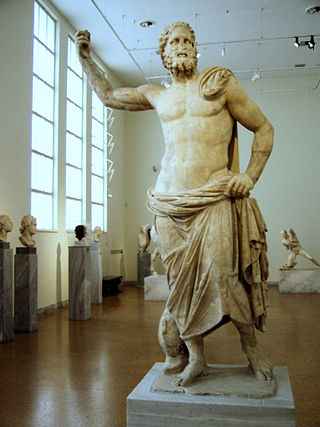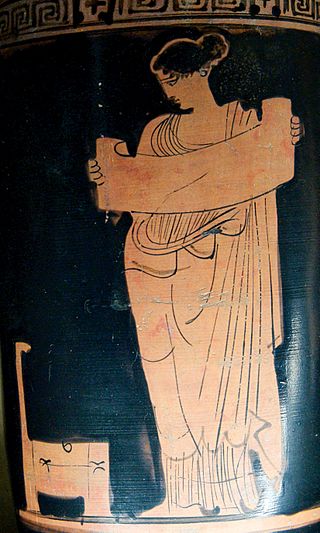
The Acropolis of Athens is an ancient citadel located on a rocky outcrop above the city of Athens, Greece, and contains the remains of several ancient buildings of great architectural and historical significance, the most famous being the Parthenon. The word Acropolis is from the Greek words ἄκρον and πόλις. The term acropolis is generic and there are many other acropoleis in Greece. During ancient times the Acropolis of Athens was also more properly known as Cecropia, after the legendary serpent-man Cecrops, the supposed first Athenian king.

A catapult is a ballistic device used to launch a projectile a great distance without the aid of gunpowder or other propellants – particularly various types of ancient and medieval siege engines. A catapult uses the sudden release of stored potential energy to propel its payload. Most convert tension or torsion energy that was more slowly and manually built up within the device before release, via springs, bows, twisted rope, elastic, or any of numerous other materials and mechanisms.

A nymph, sometimes spelled nymphe, in ancient Greek folklore is a minor female nature deity. Different from other Greek goddesses, nymphs are generally regarded as personifications of nature, are typically tied to a specific place or landform, and are usually depicted as maidens. They were immortal like other goddesses, except for the Hamadryads, whose lives were bound to a specific tree.

Poseidon is one of the Twelve Olympians in ancient Greek religion and mythology, presiding over the sea, storms, earthquakes and horses. He was the protector of seafarers and the guardian of many Hellenic cities and colonies. In pre-Olympian Bronze Age Greece, Poseidon was venerated as a chief deity at Pylos and Thebes, with the cult title "earth shaker"; in the myths of isolated Arcadia, he is related to Demeter and Persephone and was venerated as a horse, and as a god of the waters. Poseidon maintained both associations among most Greeks: he was regarded as the tamer or father of horses, who, with a strike of his trident, created springs. His Roman equivalent is Neptune.

Pegasus is a winged horse in Greek mythology, usually depicted as a white stallion. He was sired by Poseidon, in his role as horse-god, and foaled by the Gorgon Medusa. Pegasus was the brother of Chrysaor, both born when their mother was decapitated by Perseus. Greco-Roman poets wrote about his ascent to heaven after his birth and his obeisance to Zeus, who instructed him to bring lightning and thunder from Olympus.

In ancient Greek mythology and religion, Persephone, also called Kore or Cora, is the daughter of Zeus and Demeter. She became the queen of the underworld after her abduction by her uncle Hades, the king of the underworld, who would later also take her into marriage.

Castalia, in ancient Greek and Roman literature,. was the name of a spring near Delphi, sacred to the Muses; it is also known as the Castalian Spring. It is said to have derived its name from Castalia, a naiad-nymph, daughter of the river-god Achelous, who is said to have flung herself into the spring when pursued by the god Apollo.

In ancient Greek religion and mythology, the Muses are the inspirational goddesses of literature, science, and the arts. They were considered the source of the knowledge embodied in the poetry, lyric songs, and myths that were related orally for centuries in ancient Greek culture.

In Greek mythology the Horae, Horai or Hours were the goddesses of the seasons and the natural portions of time.

In Greek mythology, the naiads are a type of female spirit, or nymph, presiding over fountains, wells, springs, streams, brooks and other bodies of fresh water.
In Greek mythology, the Pegaeae were a type of naiad that lived in springs. They were often considered great aunts of the river gods (Potamoi), thus establishing a mythological relationship between a river itself and its springs.

Tarpon Springs is a city in Pinellas County, Florida, United States. Downtown Tarpon Springs has long been a focal point and underwent beautification in 2010. It is part of the Tampa Bay area. The population was 25,117 at the 2020 census.
Ouzo is a dry anise-flavored aperitif that is widely consumed in Greece. It is made from rectified spirits that have undergone a process of distillation and flavoring. Its taste is similar to other anise liquors like pastis, sambuca, rakı and arak.

A spa is a location where mineral-rich spring water is used to give medicinal baths. Spa towns or spa resorts typically offer various health treatments, which are also known as balneotherapy. The belief in the curative powers of mineral waters goes back to prehistoric times. Such practices have been popular worldwide, but are especially widespread in Europe and Japan. Day spas and medspas are also quite popular, and offer various personal care treatments.
In Greek mythology, Hegemone was a Greek goddess of plants, specifically making them bloom and bear fruit. According to Pausanias, Hegemone was a name given by the Athenians to one of the Graces. Auxo represented the spring, and Hegemone autumn.
In Greek mythology, Alseids were the nymphs of glens and groves. Of the Classical writers, the first and perhaps only poet to reference alseids is Homer. Rather than alseid he used the spelling alsea. The three uses of alsea by Homer are as follows:
"The nymphs who live in the lovely groves, and the springs of rivers and the grassy meadows ."
"They [nymphs] come from springs (krênai), they come from groves (alsea), they come from the sacred rivers flowing seawards."
"The nymphs [of Mount Ida] who haunt the pleasant woods (alsea), or of those who inhabit this lovely mountain and the springs of rivers and grassy meads (pisea)."

Eastern Mediterranean is a loose definition of the eastern approximate half, or third, of the Mediterranean Sea, often defined as the countries around the Levantine Sea.
Myrica or Myrika, also called Myrikion and Therma, was a city and bishopric in Galatia Salutaris, known for its hot springs.
Pegasides were nymphs of Greek mythology connected with wells and springs, specifically those that the mythical horse Pegasus created by striking the ground with his hooves.
Astyra, also known as Astyrum or Astyron (Ἄστυρον), and perhaps also Andeira (Ἀνδειρα), was a small town of ancient Aeolis and of Mysia, in the Plain of Thebe, between Antandrus and Adramyttium. It had a temple of Artemis, of which the Antandrii had the superintendence. Artemis had hence the name of Astyrene or Astirene. There was a lake Sapra near Astyra, which communicated with the sea. Pausanias, from his own observations, describes a spring of black water at Astyra; the water was hot. But he places Astyra in the territory of Atarneus. There was, then, either a place in Atarneus called Astyra, with warm springs, or Pausanias has made some mistake; for there is no doubt about the position of the Astyra of Strabo and Pomponius Mela. Astyra was a deserted place, according to Pliny's authorities; he calls it Astyre. There are said to be coins of Astyra.












